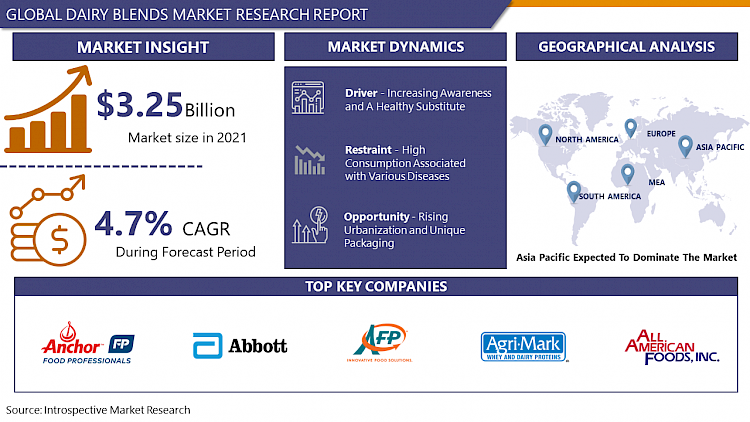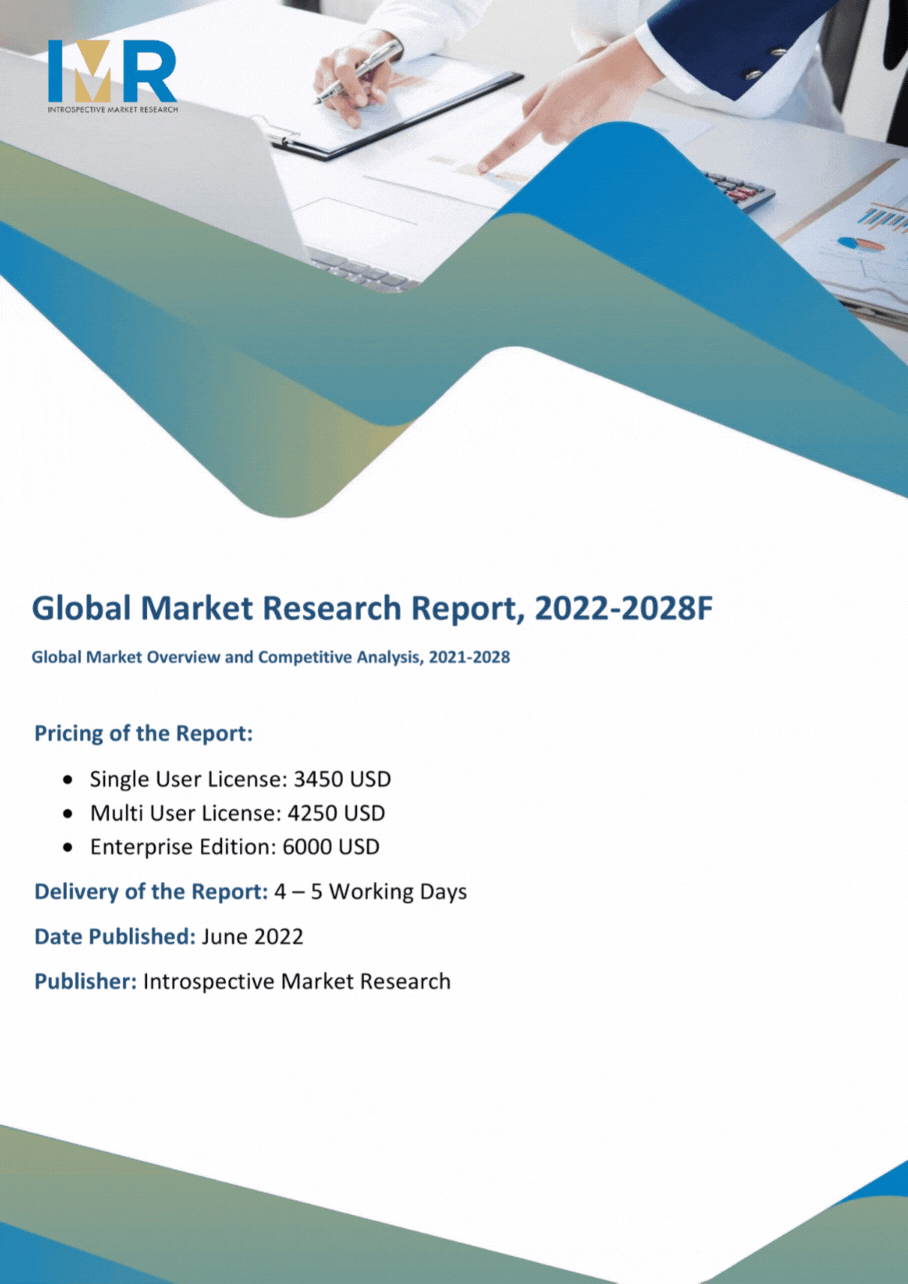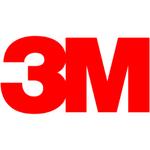Global Dairy Blends Market Overview
The Global Dairy Blends Market size is expected to grow from USD 3.40 billion in 2022 to USD 4.91 billion by 2030, at a CAGR of 4.7% during the forecast period (2023-2030).
Dairy blends are dairy mixtures which are made from concentrated cream or butter and are mixed with vegetable oils. Dairy blends provide additional nutrition and an absolute taste enhancement to the products. The high cost of traditional dairy products, combined with the significant health benefits of dairy blends, has been cushioning the dairy blends industry globally. Varied taste and flavors cater the growing demand of dairy blends market. Moreover, dairy blends can be utilized in various forms in industries. For instance, dairy blends can be used in powdered form as stabilizers and sweeteners in many icecreams and yogurts. The inclination of consumers towards a healthy and nutritious alternative with low- fat content, and great taste is most likely to drive the market growth of dairy blends in the forecasted years. Dairy blends are also an excellent option for traditional baby foods such as rice and porridge as the dairy blends help in cutting down the time needed to cook baby food. Additionally, they possess essential nutrients that enhances baby health. Thus, the numerous applications in different industries and households, product advances and the increase in blending technology are estimated to boost the dairy blends market growth over the projected period.

Market Dynamics And Factors For Dairy Blends Market
Drivers:
Increasing Awareness and A Healthy Substitute
Owing to the changes in social and economic patterns and rapid increase in awareness about healthy foods, the functional dairy blends are widely utilized in many food processing units. The demand for dairy blend products is growing faster as consumers are becoming aware about the health benefits associated by consumption such as reduced risk of diabetes, improvement in immunity and others. Dairy blends are becoming popular among the working- class people, children as well as bachelors due to the enhanced taste and a healthy substitute to the rich in oil and fat products as well as milk powders and traditional products. Healthy substitutes, such as dairy snacks from dairy blends are easily available, convenient, ready-to-eat and fuel the human body. Moreover, the changing buyer power, changes in meal pattern and food habits and the desire to switch for healthy substitutes is driving the market growth of dairy blends.
Restraints:
High Consumption Associated with Various Diseases
The dairy blends market is growing rapidly due to the high consumption of spreadable dairy blends as it can be used as a low-fat alternative to margarine and butter. However, high consumption of such blended products may lead to emergence of various diseases and restrict the growth of the dairy blends market. Consuming such products on a daily basis may cause various gastrointestinal problems and heart diseases and further cause a decline in dairy blends industry. People who are lactose intolerant may also face several side effects with the consumption of dairy blends. Henceforth, the high consumption may lead to a decline in the market growth over the projected period.
Opportunity:
Rising Urbanization and Unique Packaging
Rising urbanization and hectic lifestyle have brought a considerable impact on the dairy blends market growth in recent years. A busier lifestyle has made it more difficult for both women and men to cook food at home, and even worsens in the case of working moms who have to manage both home and kids. In such cases, dairy blends have emerged as a perfect alternative to traditional baby foods such as rice or porridge. They cut down the time for cooking food and possess essential nutrients required to promote baby health. Furthermore, the market players in the dairy blends industry are upbringing innovations with different flavors, aggressive marketing strategies and attractive packagings that garners the market growth of dairy blends and ultimately provides an opportunity for rapid development over the projected period.
Segmentation Analysis Of Dairy Blends Market
By Type, Dairy as functional ingredient is estimate to dominate the dairy blends market over the projected period. Milk and dairy products such as yogurt and cheese are essential for delivering functional ingredients. Functional foods or ingredients are essential to enhance human health and dairy blends play a vital role in supplying functional ingredients. Additionally, they also provide bioactive proteins, fiber and probiotic bacteria through consumption which drives the market growth and helps the functional ingredient segment to dominate the market.
By Application, Bakery segment is expected to hold the largest share in the upcoming years. Increase in awareness related to health benefits, is propelling the demand for low-calorie bakery products among consumers. This is estimated to boost the market for dairy blends as functional ingredients in this particular segment. Dairy blends are further a cost-effective alternative to butter, with comparatively low- fat content, and do not have any negative impact on the product taste like margarine does. Hence, their demand in bakery as a replacement for these two ingredients is rapidly increasing.
By Form, Spreadable form of dairy blends market segment is anticipated to grow rapidly in the upcoming years. The spreadable form is easy and convenient to use in various food processing units. The spreadable form is majorly used as a substitute for butter and margarine and led to rise in demand for the same. This form has many applications in industries such as bakery, ice cream, yogurt cheese & butter blends, feed and infant formula. These factors are increasing the demand for spreadable form of dairy blends.
Regional Analysis Of Dairy Blends Market
Asia-Pacific is projected to dominate the dairy blends market in thee forecasted period. Rapid increase in disposable income as well as growth in demand from developing nations such as India, Japan, China and South Korea and the presence of a large-scale dairy sector in Australia & New Zealand are most likely to drive the market growth in the Asia Pacific region. Rising concerns regarding health and rapid increase in urbanization is propelling the market growth in this region. The Asia-Pacific dairy market also shows a growing interest in dairy blends as the demand for milk fat grows. Milk fat is a natural product and offers a better taste in contrast to other vegetable fats. Counties like India produces the largest amount of milk and milk fats in the region that further adds to the growth of dairy blends market.
North America is the second region that dominates the dairy blends market. The market is characterized by huge competition owing to the presence of a number of small and large- scale firms in this region. Additionally, the presence of many food processing units creates huge demand for dairy blends as an active ingredient in processing food. Growing urbanization and lifestyle has boosted the market growth, as the working population tend to purchase products which cut down their cooking time and provide healthy and nutritious foods products. The Canada and U.s region has high demand for dairy blended products which further causes rapid rise in growth of dairy blends market.
Europe region is anticipated to grow steadily in the forecast period. Despite numerous health and nutrition advantages of dairy blends, consumers in this region are unwilling to use them over traditional dairy products. In some developed as well as developing markets, food & beverage manufacturers prefer to use butter, margarine, and other conventional dairy products instead of dairy blends. But owing to the health benefits and growing demand for dairy proteins, this region is expected to witness growth in the upcoming years. Also, the changing lifestyle and trends can boost the market growth. Thus, there is a steady growth in the European region for dairy blends market in the forecasted years.
Covid-19 Impact Analysis On Dairy Blends Market
Due to the COVID-19 pandemic, the supply chain and demand for the products have been completely disrupted. The global pandemic of COVID 19 has affected the normal working of the people and thereby the dairy blends industry adversely. This situation has pushed the consumers to prefer healthy and nutritious options of milk and dairy products. A more substantial rise in retail sales in European countries as well as the US region will foster dairy blends market value. The pace of change will propel growth in the Dairy Blends market and companies will quickly re-align their strategies and emerge stronger in the upcoming years. Owing to the lockdown and post lockdown period most of the manufacturing units of the dairy blends market were completely or partially shut down which resulted in a steep downfall of profit margins. It is expected that the dairy blends market will further recover from the COVID-19 situation at the end of the second quarter of the upcoming year during the forecasted period.
Top Key Players Covered In Dairy Blends Market
- Anchor (Auckland, New Zealand)
- Abbott Nutrition (US)
- Advanced Food Products (PA)
- Agri- Mark Inc. (US)
- Agropur Ingredients (US)
- All American Foods, Inc. (US)
- Friesland Campina (Netherlands)
- Cargill(US)
- Bakels Edible Oils (New Zealand)
- Lactopur (Canada)
- Pacificblends (Canada)
- Galloway Company (US)
- Dohler (Germany)
- Kerry Foods (Ireland)
- Fonterra Co-operative group (New Zealand) and other major players.
Key Industry Development In The Dairy Blends Market
In October 2021, Arla Foods Ingredients launched Lacprodan premium ALPHA-10, a dry-blend protein ingredient that can be beneficial for infant formula manufacturers. This blend also possesses whey protein from human milk consisting of essential amino acids.
In February 2021, Cargill launched The Chompery, a novel brand of butcher-quality dog treats. Established to attend to the most recent consumer trends, The Chompery dog treats are all organic, single-ingredient and both sourced and manufactured in the U.S. With an extensive portfolio of high-quality treats, The Chompery provides products for diversified usage occasions and intentions, inclusive of long-lasting entertainment, rewards and coaching.
|
Global Dairy Blends Market |
|||
|
Base Year: |
2022 |
Forecast Period: |
2022-2028 |
|
Historical Data: |
2017 to 2022 |
Market Size in 2022: |
USD 3.40 Bn. |
|
Forecast Period 2023-30 CAGR: |
4.7% |
Market Size in 2030: |
USD 4.91 Bn. |
|
Segments Covered: |
By Type |
|
|
|
By Application |
|
||
|
By Form |
|
||
|
By Region |
|
||
|
Key Market Drivers: |
|
||
|
Key Market Restraints: |
|
||
|
Key Opportunities: |
|
||
|
Companies Covered in the report: |
|
||
Chapter 1: Introduction
1.1 Research Objectives
1.2 Research Methodology
1.3 Research Process
1.4 Scope and Coverage
1.4.1 Market Definition
1.4.2 Key Questions Answered
1.5 Market Segmentation
Chapter 2:Executive Summary
Chapter 3:Growth Opportunities By Segment
3.1 By Type
3.2 By Application
3.3 By Form
Chapter 4: Market Landscape
4.1 Porter's Five Forces Analysis
4.1.1 Bargaining Power of Supplier
4.1.2 Threat of New Entrants
4.1.3 Threat of Substitutes
4.1.4 Competitive Rivalry
4.1.5 Bargaining Power Among Buyers
4.2 Industry Value Chain Analysis
4.3 Market Dynamics
4.3.1 Drivers
4.3.2 Restraints
4.3.3 Opportunities
4.5.4 Challenges
4.4 Pestle Analysis
4.5 Technological Roadmap
4.6 Regulatory Landscape
4.7 SWOT Analysis
4.8 Price Trend Analysis
4.9 Patent Analysis
4.10 Analysis of the Impact of Covid-19
4.10.1 Impact on the Overall Market
4.10.2 Impact on the Supply Chain
4.10.3 Impact on the Key Manufacturers
4.10.4 Impact on the Pricing
Chapter 5: Dairy Blends Market by Type
5.1 Dairy Blends Market Overview Snapshot and Growth Engine
5.2 Dairy Blends Market Overview
5.3 Dairy Mixtures
5.3.1 Introduction and Market Overview
5.3.2 Historic and Forecasted Market Size (2016-2028F)
5.3.3 Key Market Trends, Growth Factors and Opportunities
5.3.4 Dairy Mixtures: Grographic Segmentation
5.4 Dairy/Non-Dairy Ingredients
5.4.1 Introduction and Market Overview
5.4.2 Historic and Forecasted Market Size (2016-2028F)
5.4.3 Key Market Trends, Growth Factors and Opportunities
5.4.4 Dairy/Non-Dairy Ingredients: Grographic Segmentation
5.5 Dairy as Functional Ingredient
5.5.1 Introduction and Market Overview
5.5.2 Historic and Forecasted Market Size (2016-2028F)
5.5.3 Key Market Trends, Growth Factors and Opportunities
5.5.4 Dairy as Functional Ingredient: Grographic Segmentation
5.6 Dairy as Carrier
5.6.1 Introduction and Market Overview
5.6.2 Historic and Forecasted Market Size (2016-2028F)
5.6.3 Key Market Trends, Growth Factors and Opportunities
5.6.4 Dairy as Carrier: Grographic Segmentation
5.7 Others
5.7.1 Introduction and Market Overview
5.7.2 Historic and Forecasted Market Size (2016-2028F)
5.7.3 Key Market Trends, Growth Factors and Opportunities
5.7.4 Others: Grographic Segmentation
Chapter 6: Dairy Blends Market by Application
6.1 Dairy Blends Market Overview Snapshot and Growth Engine
6.2 Dairy Blends Market Overview
6.3 Ice Cream
6.3.1 Introduction and Market Overview
6.3.2 Historic and Forecasted Market Size (2016-2028F)
6.3.3 Key Market Trends, Growth Factors and Opportunities
6.3.4 Ice Cream: Grographic Segmentation
6.4 Yogurt
6.4.1 Introduction and Market Overview
6.4.2 Historic and Forecasted Market Size (2016-2028F)
6.4.3 Key Market Trends, Growth Factors and Opportunities
6.4.4 Yogurt: Grographic Segmentation
6.5 Infant Formula
6.5.1 Introduction and Market Overview
6.5.2 Historic and Forecasted Market Size (2016-2028F)
6.5.3 Key Market Trends, Growth Factors and Opportunities
6.5.4 Infant Formula: Grographic Segmentation
6.6 Bakery
6.6.1 Introduction and Market Overview
6.6.2 Historic and Forecasted Market Size (2016-2028F)
6.6.3 Key Market Trends, Growth Factors and Opportunities
6.6.4 Bakery: Grographic Segmentation
6.7 Feed
6.7.1 Introduction and Market Overview
6.7.2 Historic and Forecasted Market Size (2016-2028F)
6.7.3 Key Market Trends, Growth Factors and Opportunities
6.7.4 Feed: Grographic Segmentation
Chapter 7: Dairy Blends Market by Form
7.1 Dairy Blends Market Overview Snapshot and Growth Engine
7.2 Dairy Blends Market Overview
7.3 Spreadable
7.3.1 Introduction and Market Overview
7.3.2 Historic and Forecasted Market Size (2016-2028F)
7.3.3 Key Market Trends, Growth Factors and Opportunities
7.3.4 Spreadable: Grographic Segmentation
7.4 Powder
7.4.1 Introduction and Market Overview
7.4.2 Historic and Forecasted Market Size (2016-2028F)
7.4.3 Key Market Trends, Growth Factors and Opportunities
7.4.4 Powder: Grographic Segmentation
7.5 Liquid
7.5.1 Introduction and Market Overview
7.5.2 Historic and Forecasted Market Size (2016-2028F)
7.5.3 Key Market Trends, Growth Factors and Opportunities
7.5.4 Liquid: Grographic Segmentation
Chapter 8: Company Profiles and Competitive Analysis
8.1 Competitive Landscape
8.1.1 Competitive Positioning
8.1.2 Dairy Blends Sales and Market Share By Players
8.1.3 Industry BCG Matrix
8.1.4 Ansoff Matrix
8.1.5 Dairy Blends Industry Concentration Ratio (CR5 and HHI)
8.1.6 Top 5 Dairy Blends Players Market Share
8.1.7 Mergers and Acquisitions
8.1.8 Business Strategies By Top Players
8.2 ANCHOR (NEW ZEALAND)
8.2.1 Company Overview
8.2.2 Key Executives
8.2.3 Company Snapshot
8.2.4 Operating Business Segments
8.2.5 Product Portfolio
8.2.6 Business Performance
8.2.7 Key Strategic Moves and Recent Developments
8.2.8 SWOT Analysis
8.3 ABBOTT NUTRITION (US)
8.4 ADVANCED FOOD PRODUCTS (PA)
8.5 AGRI- MARK INC. (US)
8.6 AGROPUR INGREDIENTS (US)
8.7 ALL AMERICAN FOODS INC. (US)
8.8 FRIESLAND CAMPINA (NETHERLANDS)
8.9 CARGILL (US)
8.10 BAKELS EDIBLE OILS (NEW ZEALAND)
8.11 LACTOPUR (CANADA)
8.12 PACIFICBLENDS (CANADA)
8.13 GALLOWAY COMPANY (US)
8.14 DOHLER (GERMANY)
8.15 KERRY FOODS (IRELAND)
8.16 FONTERRA CO-OPERATIVE GROUP (NEW ZEALAND)
8.17 OTHER MAJOR PLAYERS
Chapter 9: Global Dairy Blends Market Analysis, Insights and Forecast, 2016-2028
9.1 Market Overview
9.2 Historic and Forecasted Market Size By Type
9.2.1 Dairy Mixtures
9.2.2 Dairy/Non-Dairy Ingredients
9.2.3 Dairy as Functional Ingredient
9.2.4 Dairy as Carrier
9.2.5 Others
9.3 Historic and Forecasted Market Size By Application
9.3.1 Ice Cream
9.3.2 Yogurt
9.3.3 Infant Formula
9.3.4 Bakery
9.3.5 Feed
9.4 Historic and Forecasted Market Size By Form
9.4.1 Spreadable
9.4.2 Powder
9.4.3 Liquid
Chapter 10: North America Dairy Blends Market Analysis, Insights and Forecast, 2016-2028
10.1 Key Market Trends, Growth Factors and Opportunities
10.2 Impact of Covid-19
10.3 Key Players
10.4 Key Market Trends, Growth Factors and Opportunities
10.4 Historic and Forecasted Market Size By Type
10.4.1 Dairy Mixtures
10.4.2 Dairy/Non-Dairy Ingredients
10.4.3 Dairy as Functional Ingredient
10.4.4 Dairy as Carrier
10.4.5 Others
10.5 Historic and Forecasted Market Size By Application
10.5.1 Ice Cream
10.5.2 Yogurt
10.5.3 Infant Formula
10.5.4 Bakery
10.5.5 Feed
10.6 Historic and Forecasted Market Size By Form
10.6.1 Spreadable
10.6.2 Powder
10.6.3 Liquid
10.7 Historic and Forecast Market Size by Country
10.7.1 U.S.
10.7.2 Canada
10.7.3 Mexico
Chapter 11: Europe Dairy Blends Market Analysis, Insights and Forecast, 2016-2028
11.1 Key Market Trends, Growth Factors and Opportunities
11.2 Impact of Covid-19
11.3 Key Players
11.4 Key Market Trends, Growth Factors and Opportunities
11.4 Historic and Forecasted Market Size By Type
11.4.1 Dairy Mixtures
11.4.2 Dairy/Non-Dairy Ingredients
11.4.3 Dairy as Functional Ingredient
11.4.4 Dairy as Carrier
11.4.5 Others
11.5 Historic and Forecasted Market Size By Application
11.5.1 Ice Cream
11.5.2 Yogurt
11.5.3 Infant Formula
11.5.4 Bakery
11.5.5 Feed
11.6 Historic and Forecasted Market Size By Form
11.6.1 Spreadable
11.6.2 Powder
11.6.3 Liquid
11.7 Historic and Forecast Market Size by Country
11.7.1 Germany
11.7.2 U.K.
11.7.3 France
11.7.4 Italy
11.7.5 Russia
11.7.6 Spain
11.7.7 Rest of Europe
Chapter 12: Asia-Pacific Dairy Blends Market Analysis, Insights and Forecast, 2016-2028
12.1 Key Market Trends, Growth Factors and Opportunities
12.2 Impact of Covid-19
12.3 Key Players
12.4 Key Market Trends, Growth Factors and Opportunities
12.4 Historic and Forecasted Market Size By Type
12.4.1 Dairy Mixtures
12.4.2 Dairy/Non-Dairy Ingredients
12.4.3 Dairy as Functional Ingredient
12.4.4 Dairy as Carrier
12.4.5 Others
12.5 Historic and Forecasted Market Size By Application
12.5.1 Ice Cream
12.5.2 Yogurt
12.5.3 Infant Formula
12.5.4 Bakery
12.5.5 Feed
12.6 Historic and Forecasted Market Size By Form
12.6.1 Spreadable
12.6.2 Powder
12.6.3 Liquid
12.7 Historic and Forecast Market Size by Country
12.7.1 China
12.7.2 India
12.7.3 Japan
12.7.4 Singapore
12.7.5 Australia
12.7.6 New Zealand
12.7.7 Rest of APAC
Chapter 13: Middle East & Africa Dairy Blends Market Analysis, Insights and Forecast, 2016-2028
13.1 Key Market Trends, Growth Factors and Opportunities
13.2 Impact of Covid-19
13.3 Key Players
13.4 Key Market Trends, Growth Factors and Opportunities
13.4 Historic and Forecasted Market Size By Type
13.4.1 Dairy Mixtures
13.4.2 Dairy/Non-Dairy Ingredients
13.4.3 Dairy as Functional Ingredient
13.4.4 Dairy as Carrier
13.4.5 Others
13.5 Historic and Forecasted Market Size By Application
13.5.1 Ice Cream
13.5.2 Yogurt
13.5.3 Infant Formula
13.5.4 Bakery
13.5.5 Feed
13.6 Historic and Forecasted Market Size By Form
13.6.1 Spreadable
13.6.2 Powder
13.6.3 Liquid
13.7 Historic and Forecast Market Size by Country
13.7.1 Turkey
13.7.2 Saudi Arabia
13.7.3 Iran
13.7.4 UAE
13.7.5 Africa
13.7.6 Rest of MEA
Chapter 14: South America Dairy Blends Market Analysis, Insights and Forecast, 2016-2028
14.1 Key Market Trends, Growth Factors and Opportunities
14.2 Impact of Covid-19
14.3 Key Players
14.4 Key Market Trends, Growth Factors and Opportunities
14.4 Historic and Forecasted Market Size By Type
14.4.1 Dairy Mixtures
14.4.2 Dairy/Non-Dairy Ingredients
14.4.3 Dairy as Functional Ingredient
14.4.4 Dairy as Carrier
14.4.5 Others
14.5 Historic and Forecasted Market Size By Application
14.5.1 Ice Cream
14.5.2 Yogurt
14.5.3 Infant Formula
14.5.4 Bakery
14.5.5 Feed
14.6 Historic and Forecasted Market Size By Form
14.6.1 Spreadable
14.6.2 Powder
14.6.3 Liquid
14.7 Historic and Forecast Market Size by Country
14.7.1 Brazil
14.7.2 Argentina
14.7.3 Rest of SA
Chapter 15 Investment Analysis
Chapter 16 Analyst Viewpoint and Conclusion
|
Global Dairy Blends Market |
|||
|
Base Year: |
2022 |
Forecast Period: |
2022-2028 |
|
Historical Data: |
2017 to 2022 |
Market Size in 2022: |
USD 3.40 Bn. |
|
Forecast Period 2023-30 CAGR: |
4.7% |
Market Size in 2030: |
USD 4.91 Bn. |
|
Segments Covered: |
By Type |
|
|
|
By Application |
|
||
|
By Form |
|
||
|
By Region |
|
||
|
Key Market Drivers: |
|
||
|
Key Market Restraints: |
|
||
|
Key Opportunities: |
|
||
|
Companies Covered in the report: |
|
||
LIST OF TABLES
TABLE 001. EXECUTIVE SUMMARY
TABLE 002. DAIRY BLENDS MARKET BARGAINING POWER OF SUPPLIERS
TABLE 003. DAIRY BLENDS MARKET BARGAINING POWER OF CUSTOMERS
TABLE 004. DAIRY BLENDS MARKET COMPETITIVE RIVALRY
TABLE 005. DAIRY BLENDS MARKET THREAT OF NEW ENTRANTS
TABLE 006. DAIRY BLENDS MARKET THREAT OF SUBSTITUTES
TABLE 007. DAIRY BLENDS MARKET BY TYPE
TABLE 008. DAIRY MIXTURES MARKET OVERVIEW (2016-2028)
TABLE 009. DAIRY/NON-DAIRY INGREDIENTS MARKET OVERVIEW (2016-2028)
TABLE 010. DAIRY AS FUNCTIONAL INGREDIENT MARKET OVERVIEW (2016-2028)
TABLE 011. DAIRY AS CARRIER MARKET OVERVIEW (2016-2028)
TABLE 012. OTHERS MARKET OVERVIEW (2016-2028)
TABLE 013. DAIRY BLENDS MARKET BY APPLICATION
TABLE 014. ICE CREAM MARKET OVERVIEW (2016-2028)
TABLE 015. YOGURT MARKET OVERVIEW (2016-2028)
TABLE 016. INFANT FORMULA MARKET OVERVIEW (2016-2028)
TABLE 017. BAKERY MARKET OVERVIEW (2016-2028)
TABLE 018. FEED MARKET OVERVIEW (2016-2028)
TABLE 019. DAIRY BLENDS MARKET BY FORM
TABLE 020. SPREADABLE MARKET OVERVIEW (2016-2028)
TABLE 021. POWDER MARKET OVERVIEW (2016-2028)
TABLE 022. LIQUID MARKET OVERVIEW (2016-2028)
TABLE 023. NORTH AMERICA DAIRY BLENDS MARKET, BY TYPE (2016-2028)
TABLE 024. NORTH AMERICA DAIRY BLENDS MARKET, BY APPLICATION (2016-2028)
TABLE 025. NORTH AMERICA DAIRY BLENDS MARKET, BY FORM (2016-2028)
TABLE 026. N DAIRY BLENDS MARKET, BY COUNTRY (2016-2028)
TABLE 027. EUROPE DAIRY BLENDS MARKET, BY TYPE (2016-2028)
TABLE 028. EUROPE DAIRY BLENDS MARKET, BY APPLICATION (2016-2028)
TABLE 029. EUROPE DAIRY BLENDS MARKET, BY FORM (2016-2028)
TABLE 030. DAIRY BLENDS MARKET, BY COUNTRY (2016-2028)
TABLE 031. ASIA PACIFIC DAIRY BLENDS MARKET, BY TYPE (2016-2028)
TABLE 032. ASIA PACIFIC DAIRY BLENDS MARKET, BY APPLICATION (2016-2028)
TABLE 033. ASIA PACIFIC DAIRY BLENDS MARKET, BY FORM (2016-2028)
TABLE 034. DAIRY BLENDS MARKET, BY COUNTRY (2016-2028)
TABLE 035. MIDDLE EAST & AFRICA DAIRY BLENDS MARKET, BY TYPE (2016-2028)
TABLE 036. MIDDLE EAST & AFRICA DAIRY BLENDS MARKET, BY APPLICATION (2016-2028)
TABLE 037. MIDDLE EAST & AFRICA DAIRY BLENDS MARKET, BY FORM (2016-2028)
TABLE 038. DAIRY BLENDS MARKET, BY COUNTRY (2016-2028)
TABLE 039. SOUTH AMERICA DAIRY BLENDS MARKET, BY TYPE (2016-2028)
TABLE 040. SOUTH AMERICA DAIRY BLENDS MARKET, BY APPLICATION (2016-2028)
TABLE 041. SOUTH AMERICA DAIRY BLENDS MARKET, BY FORM (2016-2028)
TABLE 042. DAIRY BLENDS MARKET, BY COUNTRY (2016-2028)
TABLE 043. ANCHOR (NEW ZEALAND): SNAPSHOT
TABLE 044. ANCHOR (NEW ZEALAND): BUSINESS PERFORMANCE
TABLE 045. ANCHOR (NEW ZEALAND): PRODUCT PORTFOLIO
TABLE 046. ANCHOR (NEW ZEALAND): KEY STRATEGIC MOVES AND DEVELOPMENTS
TABLE 046. ABBOTT NUTRITION (US): SNAPSHOT
TABLE 047. ABBOTT NUTRITION (US): BUSINESS PERFORMANCE
TABLE 048. ABBOTT NUTRITION (US): PRODUCT PORTFOLIO
TABLE 049. ABBOTT NUTRITION (US): KEY STRATEGIC MOVES AND DEVELOPMENTS
TABLE 049. ADVANCED FOOD PRODUCTS (PA): SNAPSHOT
TABLE 050. ADVANCED FOOD PRODUCTS (PA): BUSINESS PERFORMANCE
TABLE 051. ADVANCED FOOD PRODUCTS (PA): PRODUCT PORTFOLIO
TABLE 052. ADVANCED FOOD PRODUCTS (PA): KEY STRATEGIC MOVES AND DEVELOPMENTS
TABLE 052. AGRI- MARK INC. (US): SNAPSHOT
TABLE 053. AGRI- MARK INC. (US): BUSINESS PERFORMANCE
TABLE 054. AGRI- MARK INC. (US): PRODUCT PORTFOLIO
TABLE 055. AGRI- MARK INC. (US): KEY STRATEGIC MOVES AND DEVELOPMENTS
TABLE 055. AGROPUR INGREDIENTS (US): SNAPSHOT
TABLE 056. AGROPUR INGREDIENTS (US): BUSINESS PERFORMANCE
TABLE 057. AGROPUR INGREDIENTS (US): PRODUCT PORTFOLIO
TABLE 058. AGROPUR INGREDIENTS (US): KEY STRATEGIC MOVES AND DEVELOPMENTS
TABLE 058. ALL AMERICAN FOODS INC. (US): SNAPSHOT
TABLE 059. ALL AMERICAN FOODS INC. (US): BUSINESS PERFORMANCE
TABLE 060. ALL AMERICAN FOODS INC. (US): PRODUCT PORTFOLIO
TABLE 061. ALL AMERICAN FOODS INC. (US): KEY STRATEGIC MOVES AND DEVELOPMENTS
TABLE 061. FRIESLAND CAMPINA (NETHERLANDS): SNAPSHOT
TABLE 062. FRIESLAND CAMPINA (NETHERLANDS): BUSINESS PERFORMANCE
TABLE 063. FRIESLAND CAMPINA (NETHERLANDS): PRODUCT PORTFOLIO
TABLE 064. FRIESLAND CAMPINA (NETHERLANDS): KEY STRATEGIC MOVES AND DEVELOPMENTS
TABLE 064. CARGILL (US): SNAPSHOT
TABLE 065. CARGILL (US): BUSINESS PERFORMANCE
TABLE 066. CARGILL (US): PRODUCT PORTFOLIO
TABLE 067. CARGILL (US): KEY STRATEGIC MOVES AND DEVELOPMENTS
TABLE 067. BAKELS EDIBLE OILS (NEW ZEALAND): SNAPSHOT
TABLE 068. BAKELS EDIBLE OILS (NEW ZEALAND): BUSINESS PERFORMANCE
TABLE 069. BAKELS EDIBLE OILS (NEW ZEALAND): PRODUCT PORTFOLIO
TABLE 070. BAKELS EDIBLE OILS (NEW ZEALAND): KEY STRATEGIC MOVES AND DEVELOPMENTS
TABLE 070. LACTOPUR (CANADA): SNAPSHOT
TABLE 071. LACTOPUR (CANADA): BUSINESS PERFORMANCE
TABLE 072. LACTOPUR (CANADA): PRODUCT PORTFOLIO
TABLE 073. LACTOPUR (CANADA): KEY STRATEGIC MOVES AND DEVELOPMENTS
TABLE 073. PACIFICBLENDS (CANADA): SNAPSHOT
TABLE 074. PACIFICBLENDS (CANADA): BUSINESS PERFORMANCE
TABLE 075. PACIFICBLENDS (CANADA): PRODUCT PORTFOLIO
TABLE 076. PACIFICBLENDS (CANADA): KEY STRATEGIC MOVES AND DEVELOPMENTS
TABLE 076. GALLOWAY COMPANY (US): SNAPSHOT
TABLE 077. GALLOWAY COMPANY (US): BUSINESS PERFORMANCE
TABLE 078. GALLOWAY COMPANY (US): PRODUCT PORTFOLIO
TABLE 079. GALLOWAY COMPANY (US): KEY STRATEGIC MOVES AND DEVELOPMENTS
TABLE 079. DOHLER (GERMANY): SNAPSHOT
TABLE 080. DOHLER (GERMANY): BUSINESS PERFORMANCE
TABLE 081. DOHLER (GERMANY): PRODUCT PORTFOLIO
TABLE 082. DOHLER (GERMANY): KEY STRATEGIC MOVES AND DEVELOPMENTS
TABLE 082. KERRY FOODS (IRELAND): SNAPSHOT
TABLE 083. KERRY FOODS (IRELAND): BUSINESS PERFORMANCE
TABLE 084. KERRY FOODS (IRELAND): PRODUCT PORTFOLIO
TABLE 085. KERRY FOODS (IRELAND): KEY STRATEGIC MOVES AND DEVELOPMENTS
TABLE 085. FONTERRA CO-OPERATIVE GROUP (NEW ZEALAND): SNAPSHOT
TABLE 086. FONTERRA CO-OPERATIVE GROUP (NEW ZEALAND): BUSINESS PERFORMANCE
TABLE 087. FONTERRA CO-OPERATIVE GROUP (NEW ZEALAND): PRODUCT PORTFOLIO
TABLE 088. FONTERRA CO-OPERATIVE GROUP (NEW ZEALAND): KEY STRATEGIC MOVES AND DEVELOPMENTS
TABLE 088. OTHER MAJOR PLAYERS: SNAPSHOT
TABLE 089. OTHER MAJOR PLAYERS: BUSINESS PERFORMANCE
TABLE 090. OTHER MAJOR PLAYERS: PRODUCT PORTFOLIO
TABLE 091. OTHER MAJOR PLAYERS: KEY STRATEGIC MOVES AND DEVELOPMENTS
LIST OF FIGURES
FIGURE 001. YEARS CONSIDERED FOR ANALYSIS
FIGURE 002. SCOPE OF THE STUDY
FIGURE 003. DAIRY BLENDS MARKET OVERVIEW BY REGIONS
FIGURE 004. PORTER'S FIVE FORCES ANALYSIS
FIGURE 005. BARGAINING POWER OF SUPPLIERS
FIGURE 006. COMPETITIVE RIVALRYFIGURE 007. THREAT OF NEW ENTRANTS
FIGURE 008. THREAT OF SUBSTITUTES
FIGURE 009. VALUE CHAIN ANALYSIS
FIGURE 010. PESTLE ANALYSIS
FIGURE 011. DAIRY BLENDS MARKET OVERVIEW BY TYPE
FIGURE 012. DAIRY MIXTURES MARKET OVERVIEW (2016-2028)
FIGURE 013. DAIRY/NON-DAIRY INGREDIENTS MARKET OVERVIEW (2016-2028)
FIGURE 014. DAIRY AS FUNCTIONAL INGREDIENT MARKET OVERVIEW (2016-2028)
FIGURE 015. DAIRY AS CARRIER MARKET OVERVIEW (2016-2028)
FIGURE 016. OTHERS MARKET OVERVIEW (2016-2028)
FIGURE 017. DAIRY BLENDS MARKET OVERVIEW BY APPLICATION
FIGURE 018. ICE CREAM MARKET OVERVIEW (2016-2028)
FIGURE 019. YOGURT MARKET OVERVIEW (2016-2028)
FIGURE 020. INFANT FORMULA MARKET OVERVIEW (2016-2028)
FIGURE 021. BAKERY MARKET OVERVIEW (2016-2028)
FIGURE 022. FEED MARKET OVERVIEW (2016-2028)
FIGURE 023. DAIRY BLENDS MARKET OVERVIEW BY FORM
FIGURE 024. SPREADABLE MARKET OVERVIEW (2016-2028)
FIGURE 025. POWDER MARKET OVERVIEW (2016-2028)
FIGURE 026. LIQUID MARKET OVERVIEW (2016-2028)
FIGURE 027. NORTH AMERICA DAIRY BLENDS MARKET OVERVIEW BY COUNTRY (2016-2028)
FIGURE 028. EUROPE DAIRY BLENDS MARKET OVERVIEW BY COUNTRY (2016-2028)
FIGURE 029. ASIA PACIFIC DAIRY BLENDS MARKET OVERVIEW BY COUNTRY (2016-2028)
FIGURE 030. MIDDLE EAST & AFRICA DAIRY BLENDS MARKET OVERVIEW BY COUNTRY (2016-2028)
FIGURE 031. SOUTH AMERICA DAIRY BLENDS MARKET OVERVIEW BY COUNTRY (2016-2028)
Frequently Asked Questions :
The forecast period in the Dairy Blends Market research report is 2023-2030.
Anchor (Auckland, New Zealand), Abbott Nutrition (US), Advanced Food Products (PA), Agri- Mark Inc. (US), Agropur Ingredients (US), All American Foods, Inc. (US), Friesland Campina (Netherlands), Cargill (US), Bakels Edible Oils (New Zealand), Lactopur (Canada), Pacificblends (Canada), Galloway Company (US), Dohler (Germany), Kerry Foods (Ireland), Fonterra Co-operative group (New Zealand), and other major players.
The Dairy Blends Market is segmented into type, application, form and region. By Type, the market is categorized into Dairy Mixtures, Dairy/Non-dairy ingredients, Dairy as functional ingredient, Dairy as carrier, others. By Application, the market is categorized into Ice cream, Yogurt, Infant formula, Bakery, Feed. By Form, the market is categorized into spreadable, powder, liquid. By region, it is analyzed across North America (U.S.; Canada; Mexico), Europe (Germany; U.K.; France; Italy; Russia; Spain, etc.), Asia-Pacific (China; India; Japan; Southeast Asia, etc.), South America (Brazil; Argentina, etc.), Middle East & Africa (Saudi Arabia; South Africa, etc.).
Dairy blends are dairy mixtures which are made from concentrated cream or butter and are mixed with vegetable oils. Dairy blends provide additional nutrition and an absolute taste enhancement to the products which drives the market growth.
The Global Dairy Blends Market size is expected to grow from USD 3.40 billion in 2022 to USD 4.91 billion by 2030, at a CAGR of 4.7% during the forecast period (2023-2030).


































